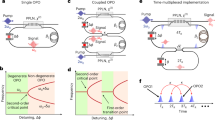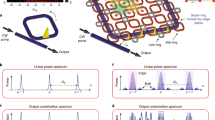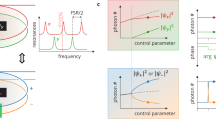Abstract
Topological phases feature robust edge states that are protected against the effects of defects and disorder. These phases have largely been studied in conservatively coupled systems, in which non-trivial topological invariants arise in the energy or frequency bands of a system. Here we show that, in dissipatively coupled systems, non-trivial topological invariants can emerge purely in a system’s dissipation. Using a highly scalable and easily reconfigurable time-multiplexed photonic resonator network, we experimentally demonstrate one- and two-dimensional lattices that host robust topological edge states with isolated dissipation rates, measure a dissipation spectrum that possesses a non-trivial topological invariant, and demonst rate topological protection of the network’s quality factor. The topologically non-trivial dissipation of our system exposes new opportunities to engineer dissipation in both classical and quantum systems. Moreover, our experimental platform’s straightforward scaling to higher dimensions and its ability to implement inhomogeneous, non-reciprocal and long range couplings may enable future work in the study of synthetic dimensions.
This is a preview of subscription content, access via your institution
Access options
Access Nature and 54 other Nature Portfolio journals
Get Nature+, our best-value online-access subscription
$29.99 / 30 days
cancel any time
Subscribe to this journal
Receive 12 print issues and online access
$209.00 per year
only $17.42 per issue
Buy this article
- Purchase on Springer Link
- Instant access to full article PDF
Prices may be subject to local taxes which are calculated during checkout






Similar content being viewed by others
Data availability
The data used to generate the plots and results in this paper is available on the Caltech Research Data Repository (https://doi.org/10.22002/D1.2202). Source data are provided with this paper. All other data that support the findings of this study are available from the corresponding author upon reasonable request.
Code availability
The code used to analyse and plot the data in this paper is available on the Caltech Research Data Repository (https://doi.org/10.22002/D1.2202). The other code supporting the findings of this study is available from the corresponding author upon reasonable request.
References
Hasan, M. & Kane, C. Colloquium: topological insulators. Rev. Mod. Phys. 82, 3045 (2010).
Cooper, N., Dalibard, J. & Spielman, I. Topological bands for ultracold atoms. Rev. Mod. Phys. 91, 015005 (2019).
Ozawa, T. et al. Topological photonics. Rev. Mod. Phys. 91, 015006 (2019).
Jackiw, R. & Rebbi, C. Solitons with fermion number 1/2. Phys. Rev. D 13, 3398 (1976).
Hatsugai, Y. Chern number and edge states in the integer quantum Hall effect. Phys. Rev. Lett. 71, 3697–3700 (1993).
Metelmann, A. & Clerk, A. Nonreciprocal photon transmission and amplification via reservoir engineering. Phys. Rev. X 5, 021025 (2015).
Mukherjee, S. et al. Dissipatively coupled waveguide networks for coherent diffusive photonics. Nat. Commun. 8, 1909 (2017).
Ding, J., Belykh, I., Marandi, A. & Miri, M.-A. Dispersive versus dissipative coupling for frequency synchronization in lasers. Phys. Rev. Appl. 12, 054039 (2019).
Barreiro, J. T. et al. An open-system quantum simulator with trapped ions. Nature 470, 486–491 (2011).
Haus, H. Mode-locking of lasers. IEEE J. Sel. Topics Quantum Electron. 6, 1173–1185 (2000).
Wright, L. G. et al. Mechanisms of spatiotemporal mode-locking. Nat. Phys. 16, 565–570 (2020).
Verstraete, F., Wolf, M. M. & Cirac, J. I. Quantum computation and quantum-state engineering driven by dissipation. Nat. Phys. 5, 633–636 (2009).
Marandi, A., Wang, Z., Takata, K., Byer, R. L. & Yamamoto, Y. Network of time-multiplexed optical parametric oscillators as a coherent Ising machine. Nat. Photon. 8, 937–942 (2014).
Inagaki, T. et al. A coherent Ising machine for 2000-node optimization problems. Science 354, 603–606 (2016).
Fang, K. et al. Generalized non-reciprocity in an optomechanical circuit via synthetic magnetism and reservoir engineering. Nat. Phys. 13, 465–471 (2017).
Wanjura, C. C., Brunelli, M. & Nunnenkamp, A. Topological framework for directional amplification in driven-dissipative cavity arrays. Nat. Commun. 11, 3149 (2020).
Gneiting, C., Koottandavida, A., Rozhkov, A. V. & Nori, F. Unraveling the topology of dissipative quantum systems. Preprint at https://arxiv.org/abs/2007.05960 (2020).
Dasbiswas, K., Mandadapu, K. K. & Vaikuntanathan, S. Topological localization in out-of-equilibrium dissipative systems. Proc. Natl Acad. Sci. USA 115, E9031–E9040 (2018).
Li, M., Ni, X., Weiner, M., Alù, A. & Khanikaev, A. B. Topological phases and nonreciprocal edge states in non-Hermitian Floquet insulators. Phys. Rev. B 100, 045423 (2019).
Wang, K. et al. Generating arbitrary topological windings of a non-Hermitian band. Science 371, 1240–1245 (2021).
Mukherjee, S. & Rechtsman, M. C. Observation of Floquet solitons in a topological bandgap. Science 368, 856–859 (2020).
Maczewsky, L. et al. Nonlinearity-induced photonic topological insulator. Science 370, 701–704 (2020).
Xia, S. et al. Nonlinear tuning of PT-symmetry and non-Hermitian topological states. Science 372, 72–76 (2021).
Zhao, H. et al. Topological hybrid silicon microlasers. Nat. Commun. 9, 981 (2018).
Zhao, H. et al. Non-Hermitian topological light steering. Science 365, 1163–1166 (2019).
Weidemann, S. et al. Topological funneling of light. Science 368, 311–314 (2020).
Bardyn, C.-E. et al. Topology by dissipation. New J. Phys. 15, 085001 (2013).
Yoshida, T. & Hatsugai, Y. Bulk edge correspondence of classical diffusion phenomena. Sci. Rep. 11, 888 (2021).
Ozawa, T. & Price, H. Topological quantum matter in synthetic dimensions. Nat. Rev. Phys. 1, 349–357 (2019).
Yuan, L., Lin, Q., Xiao, M. & Fan, S. Synthetic dimension in photonics. Optica 5, 1396–1405 (2018).
Wimmer, M., Price, H., Carusotto, I. & Peschel, U. Experimental measurement of the Berry curvature from anomalous transport. Nat. Phys. 13, 545–550 (2017).
Chen, C. et al. Observation of topologically protected edge states in a photonic two- dimensional quantum walk. Phys. Rev. Lett. 121, 100502 (2018).
Chalabi, H. et al. Synthetic gauge field for two-dimensional time-multiplexed quantum random walks. Phys. Rev. Lett. 123, 150503 (2019).
Lustig, E. et al. Photonic topological insulator in synthetic dimensions. Nature 567, 356–360 (2019).
Dutt, A. et al. A single photonic cavity with two independent physical synthetic dimensions. Science 367, 59–64 (2020).
Zeuner, J. et al. Observation of a topological transition in the bulk of a non-Hermitian system. Phys. Rev. Lett. 115, 040402 (2015).
Weimann, S. et al. Topologically protected bound states in photonic parity–time-symmetric crystals. Nat. Mater. 16, 433–438 (2017).
Su, W. P., Schrieffer, J. R. & Heeger, A. J. Solitons in polyacetylene. Phys. Rev. Lett. 42, 1698–1701 (1979).
Hofstadter, D. Energy levels and wave functions of Bloch electrons in rational and irrational magnetic fields. Phys. Rev. B 14, 2239–2249 (1976).
Harper, P. G. The general motion of conduction electrons in a uniform magnetic field, with application to the diamagnetism of metals. Proc. Phys. Soc. A 68, 879 (1955).
Diehl, S., Rico, E., Baranov, M. A. & Zoller, P. Topology by dissipation in atomic quantum wires. Nat. Phys. 7, 971–977 (2011).
Bell, B. A. et al. Spectral photonic lattices with complex long-range coupling. Optica 4, 1433–1436 (2017).
Asbóth, J., Oroszlány, L. & Pályi, A. A Short Course on Topological Insulators 1st edn (Springer, 2016).
Malkova, N., Hromada, I., Wang, X., Bryant, G. & Chen, Z. Observation of a topological transition in the bulk of a non-Hermitian system. Phys. Rev. Lett. 115, 040402 (2015).
Hafezi, M., Mittal, S., Fan, J., Migdall, A. & Taylor, J. M. Imaging topological edge states in silicon photonics. Nat. Photon. 7, 1001–1005 (2013).
Rechtsman, M. C. et al. Photonic Floquet topological insulators. Nature 496, 196–200 (2013).
Zhang, S.-C. & Hu, J. A four-dimensional generalization of the quantum Hall effect. Science 294, 823–828 (2001).
Petrides, I., Price, H. M. & Zilberberg, O. Six-dimensional quantum Hall effect and three-dimensional topological pumps. Phys. Rev. B 98, 125431 (2018).
Lohse, M., Schweizer, C., Price, H. M., Zilberberg, O. & Bloch, I. Exploring 4D quantum Hall physics with a 2D topological charge pump. Nature 553, 55–58 (2018).
Zilberberg, O. et al. Photonic topological boundary pumping as a probe of 4D quantum Hall physics. Nature 553, 59–62 (2018).
Wang, K. et al. Multidimensional synthetic chiral-tube lattices via nonlinear frequency conversion. Light Sci. Appl. 9, 132 (2020).
Fang, K. & Fan, S. Controlling the flow of light using the inhomogeneous effective gauge field that emerges from dynamic modulation. Phys. Rev. Lett. 111, 203901 (2013).
Helbig, T. et al. Generalized bulk-boundary correspondence in non-Hermitian topolectrical circuits. Nat. Phys. 16, 747–750 (2020).
Parto, M., Liu, Y., Bahari, B., Khajavikhan, M. & Christodoulides, D. Non-Hermitian and topological photonics: optics at an exceptional point. Appl. Phys. Rev. 10, 403–423 (2020).
Smirnova, D., Leykam, D., Chong, Y. & Kivshar, Y. Nonlinear topological photonics. Appl. Phys. Rev. 7, 021306 (2020).
Yuan, L., Xiao, M., Lin, Q. & Fan, S. Synthetic space with arbitrary dimensions in a few rings undergoing dynamic modulation. Phys. Rev. B 97, 104105 (2018).
Aster, R. C., Borchers, B. & Thurber, C. H. Parameter Estimation and Inverse Problems 2nd edn (Elsevier Science and Technology, 2013).
Acknowledgements
We are grateful to M. Fraser and A. Szameit for their insights. We acknowledge support from ARO grant no. W911NF-18-1-0285 and NSF grant nos. 1846273 and 1918549. S.F. acknowledges support of a Vannevar Bush Faculty Fellowship from the US Department of Defense (grant no. N00014-17-1-3030). L.Y. acknowledges support of the National Natural Science Foundation of China (11974245). F.N. acknowledges support from ARO (W911NF-18-1-0358), JST-CREST (JPMJCR1676), JSPS (JP20H00134), AOARD (FA2386-20-1-4069) and FQXi (FQXi-IAF19-06). We wish to thank NTT Research for their financial and technical support.
Author information
Authors and Affiliations
Contributions
C.L., A.D. and A.M. devised the experiments and the underlying theory. C.L., A.D. and J.W. constructed and performed the experiments. C.L. collected and analysed the data. M.P. contributed to the theoretical analysis. L.Y. conceived the experiment. S.F. and F.N. provided additional insights and guidance. All the authors discussed the results and contributed to the writing of the manuscript. A.M. supervised the project.
Corresponding author
Ethics declarations
Competing interests
The authors declare no competing interests.
Peer review
Peer review information
Nature Physics thanks Yaakov Lumer and the other, anonymous, reviewer(s) for their contribution to the peer review of this work.
Additional information
Publisher’s note Springer Nature remains neutral with regard to jurisdictional claims in published maps and institutional affiliations.
Supplementary information
Supplementary Information
Supplementary Figs. 1–17 and Sections 1–8.
Source data
Source Data Fig. 5
A compressed file containing the processed data plotted in Fig. 5b,c.
Rights and permissions
About this article
Cite this article
Leefmans, C., Dutt, A., Williams, J. et al. Topological dissipation in a time-multiplexed photonic resonator network. Nat. Phys. 18, 442–449 (2022). https://doi.org/10.1038/s41567-021-01492-w
Received:
Accepted:
Published:
Issue Date:
DOI: https://doi.org/10.1038/s41567-021-01492-w
This article is cited by
-
Quantized topological pumping in Floquet synthetic dimensions with a driven dissipative photonic molecule
Nature Physics (2024)
-
Topological temporally mode-locked laser
Nature Physics (2024)
-
Parity–time-symmetric photonic topological insulator
Nature Materials (2024)
-
Realization of photonic p-orbital higher-order topological insulators
eLight (2023)
-
Resonators with tailored optical path by cascaded-mode conversions
Nature Communications (2023)



